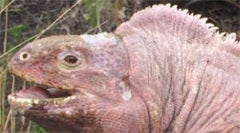Rare, Storied Pink Iguana Discovered
Just in time to deem it endangered, scientists discover an elusive new species of iguana on the Galapagos


Pink Iguana
Darwin’s visit to the Galapagos in 1835 missed finding a new species that has eluded generations of scientists until now – the “rosada” land iguana.
New to science, yes, but the iguana’s lineage marks one of the oldest cases of divergence from other species on the Galapagos. Scientists were surprised to date the species’ origin to more than five million years ago, before some of the islands had even formed.
A pink and black-striped pattern sets the iguana apart from the yellow land iguanas found previously on the islands. Darwin had little good to say about either the land or marine iguanas he encountered on his trip, merely noting that land iguanas are “hideous animals, but are considered good food.”
Perhaps the famed English naturalist might be forgiven for not exploring Volcan Wolf volcano on the island of Isabela, the only place where the pink iguanas live. Treacherous volcanic rocks in the area challenge even modern-day scientists who traverse the bleak landscape.
Even after the first pink iguana sighting came in 1986, no scientists bothered to actually examine the creatures until recently. Now it’s a race against time, given that the lizard already meets the criteria of a critically endangered species.
“These findings call for a conservation program aimed at evaluating the risk of extinction of this newly recognized species,” wrote Gabriele Gentile, of Tor Vergata University of Rome, Italy, and colleagues in the latest issue of the_ Proceedings of the National Academy of Sciences_.
Volcan Wolf volcano may yet turn up more surprises for researchers on the Galapagos. Scientists earlier found that a giant tortoise species marked as extinct has lived on through hybrid descendants in the same region.
Endangered status aside, the latest iguana known to science can rest a bit easy in one respect. Pink and black with that mug won’t win fashion awards, but it also won’t earn a spot on this list.